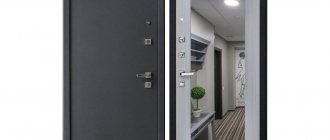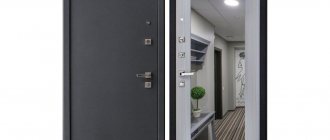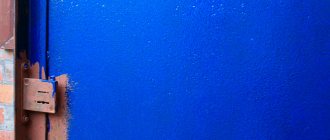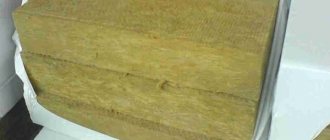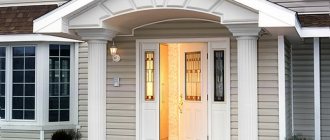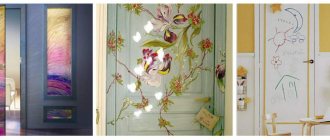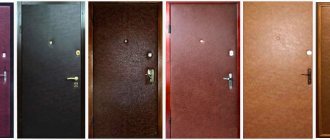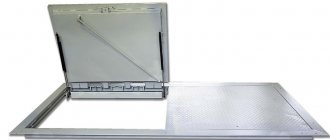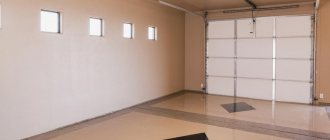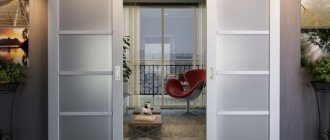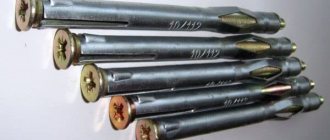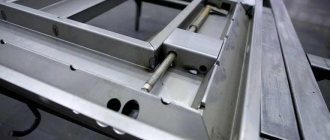The entrance door to an apartment or private residential building is part of the enclosing structure, which is why it is subject to increased requirements for burglary resistance, heat and sound insulation. In addition, the interior side of the structure must be combined with the overall style of decoration of the hall or hallway. Many companies offer ready-made decorative finishes for this structural element. If the owner of the premises does not have the opportunity to purchase a complete product, he needs to know how to decorate the front door from the inside with his own hands.
Inner side of the front door
The most popular methods for decorating the front door from the inside
When decorating the interior, designers recommend that customers use the following technologies for finishing the inner surface of the front door:
- Coating a steel sheet, plywood or OSB with a paint and varnish composition in a single color scheme, or with a shagreen effect. Most often, manufacturers use the principle of hammer painting with special pigment substances for metal, as they increase the corrosion resistance of the material and give a decent appearance to the surface.
Plywood door covering
- Upholstery of the inside of the door with leather or substitutes for natural materials with padding of the internal space with elastic inserts, for example, batting. This finishing option significantly increases the heat transfer resistance of the enclosing structure.
Carriage tie
- Interior cladding made of rigid panels - MDF, chipboard, plywood with textured color lamination. Materials can be combined with various inserts, including mirrors and steel overlays, which is especially important for high-tech interiors.
Door with MDF panel
- In many hardware stores you can find polymer stickers that are fixed to the smooth and grease-free surface of the door, creating the illusion of a beautiful landscape and other interesting images.
Stickers on the front door
When finishing an exclusive interior, designers also often personally decorate the front door, resorting to the technique of aging wood, brushing or decoupage. As a result of many hours of work, the result is an interesting vintage interior, or a pronounced “country” style.
Application of brushing technology
How to finish a door
The front door can be made of different materials, which can be painted, upholstered or sheathed. Each method has its pros and cons. Finishing begins after installing the product along with the door frame in the opening.
Painting
The entrance door can be painted with latex, water-based or oil-based paint. The color of the painting material is selected so that it is the same as the wall decoration or contrasts with it. Before applying the paint, the surfaces are well prepared, after which the coating is applied in two layers.
The features of this finishing option are simplicity, high speed and relatively low cost of paint. No special tools are required to apply the material; you can use just one brush.
The disadvantages include the impossibility of sound and heat insulation.
Upholstery
Thick fabric, leatherette or genuine leather are suitable as upholstery material for the entrance door from the inside. Additional elements will require a special thread and carnations. Upholstery of canvas with modern leatherette looks expensive, brings warmth and comfort to the room, and protects well from noise and cold.
The most affordable material is leatherette, which is characterized not only by a low price, but also by the following advantages:
- abrasion resistance;
- durability;
- ease of care;
- wide choice of color shades.
Despite all the advantages, the material also has disadvantages:
- flammability;
- easy to damage with a sharp object;
- impossibility of high-quality restoration of the coating.
Sheathing
To ensure that the front door is finished with high quality, lining, PVC panels, and chipboard are used. Decorating the canvas with such materials has practically no disadvantages. A similar finish can be used for lining doors made of both wood and metal. As a result, good heat and sound insulation is ensured and the service life of the door is increased. Such materials have a wide variety of textures and colors to suit any interior design.
The most commonly used materials for finishing the inside of the door
The methods listed above allow you to realize any designer’s idea, provided the following materials are available:
- Natural wood of valuable species - oak, walnut, beech, and ash.
Natural wood paneling
- Boards made of natural coniferous materials - pine, cedar.
Pine paneling
- Genuine leather for carriage screed.
Covering with genuine leather
- Leatherette for soft upholstery.
Leatherette upholstery
- Ready-made MDF panels.
MDF panel in assortment
- Chipboard or OSB sheets, moisture-resistant plywood.
OSB sheets for the door
- Laminated film.
Film sticker
- Nitro paints, alkyd, acrylic, hammer, oil or other paints and varnishes.
Dyed canvas
- Carpeting, laminate and other materials used as floor finishing.
Laminate as a finishing material
Large factories that supply doors of modular dimensions, or on individual orders from premises owners, usually use the technology of constructing MDF panels with high-quality lamination. Modern materials in this category are characterized by increased wear resistance, durability, and are resistant to mechanical damage and temperature changes.
Factory for the production of entrance doors
Slope finishing
Finishing slopes from the inside with artificial stone
The process of finishing slopes is no different from finishing work in rooms:
- Laminate and MDF panels are installed on a thin layer of mounting foam, which fills the space between the wall and the material.
- The finishing stone is attached to a special resin or liquid nails.
Finishing a doorway with decorative stone has its own characteristics. It is recommended to use plaster with the addition of alabaster. It adheres to the wall more securely than drywall, which may not withstand the weight of the finishing material.
Sometimes clinker bricks are used to finish slopes. In this case, it is advisable to use the same material to decorate the outer corners of the part of the wall where the doorway is located.
How to paint the inside of your front door yourself
To paint a door with your own hands, a home craftsman will not need special skills or complex professional tools. At the same time, the finishing materials market offers many options for paints with different compositions and shades intended for painting metal, wood, plastic and other surfaces.
Paints for processing metal doors
This type of finishing of the interior side of the door has many undeniable advantages:
- First of all, painting is the cheapest finishing option, and, compared to other types of decor, it does not require the purchase of a large number of high-quality materials.
Metal processing with primer
- To apply an even layer, you only need a paint composition from a trusted manufacturer, as well as a high-quality brush. The simplicity of this solution eliminates the need to turn to expensive professionals to complete the work. Painting can be done by any home craftsman, regardless of age, gender and experience.
Tool for painting door panels
- Various color options in a matte finish or with a glossy finish are widely available, as well as textured paints, which make it easy to create an original surface stylized as natural wood or stone.
Textured hammer paint
- The possibility of combining different colors, as well as creating patterns or ornaments on the surface of the interior side of the door.
Drawings on the front door
To paint the entrance door leaf with your own hands, you should stock up on simple painting tools, solvent or other degreaser, paint, and carry out all work according to the following flow chart:
- All fittings that could interfere with painting - handles, locks, peepholes - are removed from the canvas.
Removing the handle
- The surface is cleaned of the old coating, after which it is polished with abrasive disk attachments on an electric drill.
Surface cleaning
- After cleaning, the inside of the door is swept and degreased with a solvent or alcohol-containing liquid.
Surface degreasing
- A protective film is glued around the perimeter of the door, as well as on the floor, to protect finishing materials from paint.
Sticker of protective materials
- The surface of the door is primed with a protective compound, which simultaneously prevents the metal from corrosion and promotes better adhesion of the material.
Corrosion protection
- On the primed surface, after the protective composition has dried, paint is applied in an even layer in one direction. The best solution is to move a roller or brush along the long side of the door leaf.
Painting a metal surface
- If it is necessary to apply two or more layers, wait time for the composition to polymerize, after which the procedure is repeated.
Waiting for polymerization
- After applying the last layer, in order not to damage the freshly painted surface, during the next 24 hours you should operate the door with extreme caution, avoiding contact with the interior surface.
Door operation
When painting a door, you should make sure in advance that each layer is applied evenly, because after the substance has polymerized, it is almost impossible to restore an unpainted surface without a trace.
Evenly applied layer
How and with what to decorate a wooden entrance door from the inside: ideas, options, tips, photos
- The old entrance door surface can be restored using liquid wallpaper. This coating will help to quickly update the door structure, but in conditions of high humidity it will quickly lose its original appearance. Therefore, it is better not to use such material for cladding kitchen doors or bathroom door panels.
- A mirror surface is suitable for restoring a wooden door block. This method of covering a door visually expands the space and enhances the light.
- Commercially available acrylic mirrors of various shades can be selected to create the effect of a mirror panel on the door.
- Lightweight plexiglass is used as a facing material. However, this type of mirror surface is an expensive way to finish a door structure.
Liquid wallpaper is used to update the front door.
How to restore the front door using a mirror finish?
- The surface of the door is leveled and coated with putty.
- Cracks, scratches, and gouges are covered and sanded.
- The surface of the door is treated with a primer.
- Mirror plastic is attached to the door leaf.
- Assembly adhesive is applied to the dried primer layer, and the panels are attached to the door leaf around the perimeter.
- Beautiful elements can be created from shaped acrylic mirrors by fixing them in the center of the door.
Covering the entrance door with mirrors
How to decorate the entrance door leaf using buckwheat husks?
- We remove the paint layer of the door leaf.
- Apply putty to the uneven areas.
- Place the door removed from its hinges on a stool.
- Paint the work surface dark brown.
- Apply a layer of PVC glue.
- Lay out the husks, distributing them evenly with your hands. You can make some kind of design or ornament out of the husks, or you can combine the decor with husks and sparkles.
- Apply 2-3 layers of matte or glossy varnish. This will help securely fasten the buckwheat husk to the canvas.
How to do door trim yourself
Another popular way to improve the front door is to upholster the door with leather, leatherette with a soft filler. Such a surface provides comfort, helps retain heat, prevents the spread of vibration, is easy to clean and lasts for decades, subject to careful handling.
Door upholstery in the interior
To do the door upholstery with your own hands, you need to buy fabric or eco-leather in a textile and hardware store, filler - batting, as well as a set of decorative nails with wire for installing a screed.
Upholstery set
When installing soft door trim, the home master must sequentially perform the following algorithm:
- Similar to the previous method, handles and other fittings are removed from the surface.
Door upholstery nails
- Before starting work, the door must be dismantled from the hinge hangers and carefully laid on a flat horizontal surface. Considering the large weight of the metal product, it is better to do this work together.
Leatherette and batting for upholstery
- All elements of the old finish are removed from the inside of the canvas, the surface is brought to a smooth state and degreased with white spirit.
Applying glue
- The plane of the upcoming finishing is treated with an adhesive compound - glue based on epoxy resin or silicone sealant, after which the soft filler is carefully laid out on it, in an even layer, without the formation of empty areas.
Gluing the filler
- The upholstery material is carefully applied to the surface of the canvas so that there are overhangs of equal size on each side.
- Consistently, using quick-drying glue, the edges are folded and fixed along the entire perimeter of the door, with force. As a result, you should get a uniform, moderately stretched surface, without folds or bends.
- Excess material around the perimeter of the canvas is trimmed with scissors or a construction knife.
Leatherette sticker
- At the location of the peephole and locks, the material is cut out with a knife, and the edges are carefully glued to the plane of the door.
- If heat-insulating rollers are supplied with the upholstery material, they are also fixed with glue around the perimeter of the product.
- At the final stage, a tie is made of wire and decorative nails on the surface of the door.
- The drawing should be drawn in advance with a pencil on the surface of the material, and then installation of the screed should begin.
Screed device
When the screed is completed, it is recommended to check the reliability of compliance with each mating line, then install the canvas in place and re-mount the fittings.
What is door restoration
Metal entrance doors are very popular, this is explained by their high reliability, durability, beautiful appearance and long service life. If a high-quality structure is installed, it will serve reliably for several decades. During operation of the front door, it is exposed to the negative influence of external factors, so over time it loses its original appearance. Situations may arise when the design of the house has been changed inside or outside and the old door does not fit into it. In such cases, there is no need to rush to change the front door, it can be restored, it is not very difficult and you can handle this kind of work yourself.
Before deciding on the need to restore the front door, you first need to check its functionality and determine whether it has retained its heat and sound insulation characteristics. In most cases, the design remains fully functional, so to update it, you just need to change the appearance.
It is much cheaper to restore a metal entrance door than to install a new one
When dismantling an old door and installing a new one, you will have to refinish the doorway, and this not only requires additional funds, but there will also be a lot of dust and debris in the house. During the restoration of the door leaf, it is not necessary to dismantle it; such work is dust-free and everything can be done independently. Depending on the restoration method chosen, you will need a maximum of 40% of the cost of the new door. If you have high-quality doors installed, then you should not rush to replace them; you risk purchasing low-quality structures. By restoring your front door, you get a beautiful and reliable solution, improve its sound and heat insulation characteristics and at the same time save significant money.
How to properly decoupage the front door
Creative painstaking work that turns the door into a decorative element of any interior. The entire operation takes a whole day, depending on the complexity of the design, and is performed in compliance with the following nuances:
- As in all previous options, all fittings are removed from the door, after which the door leaf is removed from the hinges.
- The surface is cleaned of the old finishing coating and sanded until a smooth surface and a metallic shine are achieved.
- The entire inside of the door is degreased with special paint chemicals.
Decoupage doors in the interior
- The owner of the premises initially purchases stickers made of polymer film, which can be installed entirely or different elements for appliqué can be cut out of them, according to a previously developed sketch.
Material for decoupage
- To glue decorative elements, you will need PVA glue, which is first diluted in clean warm water.
- Before sticking the pictures, you should first outline them on the surface of the door with a simple pencil.
Outlining drawings
- Each element of the applique is carefully treated with glue, pressed against the surface, smoothed and pressed for a few seconds.
Applique sticker
- When the adhesive composition polymerizes, the surface of the material should be coated with high-quality varnish, which will smooth out all irregularities and reliably protect the product from destruction.
This method of decoration will not only improve the door at minimal cost. The material, coated with varnish, is reliable and durable, resistant to scratches, and can be easily wet cleaned. The only drawback of the technique is the need to contact artists or designers, since not every average person will be able to perform such creative work.
How and with what to decorate a wooden entrance door from the inside: ideas, options, tips, photos
- Specialized stores offer a wide range of entrance door blocks. The quality of the facing material of the door structure may not meet the high demands of apartment owners.
- And the seemingly strong entrance block becomes unusable ahead of schedule. Of course, the situation is easily fixable if the apartment owner has enough funds to completely replace this important structural element.
- However, not all citizens have this opportunity. In this case, options are considered for purchasing facing materials that imitate various textured surfaces: wood, marble, glass.
- The result of simple manipulations performed independently, without the involvement of specialists, will be a complete restoration of the entrance door structure, which has lost its presentable appearance.
Facing the entrance door with laminate
If you set out to update the entrance door block beyond recognition, then the material in our article will be useful to you.
Materials that are used to carry out the restoration of the entrance door structure.
The decor of the entrance door block is made using:
- Inexpensive leatherette
- Self-adhesive PVC film
- Veneer or laminate
- MDF panels (in construction stores there are various color variations of this material)
- Plastic
- Various overlays for wood
- paint layer
The door structure can be restored by applying a layer of paint.
All these materials are used to replace the entrance door structure that has lost its external luster.
How to make an original lining of the entrance door block?
- If the hallway is small, then an interesting design option would be a mirrored entrance door. Such cladding will cost a pretty penny, but will turn the old entrance block into a real exclusive.
- You can cladding a door structure at minimal cost by using a material such as laminate. This facing material is presented in construction stores in various texture and color options, which will provide an individual and attractive look to the entrance door structure.
What you should pay attention to when choosing a material for upgrading the entrance door structure:
- The material must be safe
- The facing material must be resistant to corrosion
- The cladding must retain its original appearance, despite significant temperature fluctuations
- The material for cladding must be selected in accordance with the interior design of the room, and also take into account the view from the outside.
- Today, the assortment includes various economical options for durable and presentable cladding, suitable for the restoration of door structures.
Standard door sizes
Modern material for covering door blocks meets quality standards and is fireproof. It can be installed in common areas.
To carry out the restoration of the old entrance block structure, we offer detailed instructions:
- We select the finishing material, having previously calculated the linear footage corresponding to the dimensions of the door structure.
- If you plan to repair or update door slopes, then their dimensions are included in the linear footage.
The next step is to prepare the tools. To work you will need:
- simple pencil
- screwdriver
- sacral screwdriver
- pliers
- Bulgarian
- brushes
- glue
Before the restoration begins, the door leaf is removed from the hinges and installed on a horizontal plane.
Instructions for lining the entrance door block with laminate
- At the beginning of the work, we will remove the outdated door structure from the fastening elements.
- Place the door on a flat surface.
- We dismantle the handles, existing rim locks, and the peephole. It is important that before starting restoration, the surface of the door is free of protrusions.
- We take measurements of the door, taking into account the dimensions of the door leaf itself and the slopes.
- We cut the facing material (laminate) in accordance with the previously taken measurements.
- We fix the laminate board with liquid nails. To do this, we apply the facing material evenly to the surface of the door and the walls that form the slopes.
- If you plan to finish the door surface with scraps of laminate boards, then cut out geometric shapes of the desired sizes (squares, triangles).
- Laminate panels are installed on the restored door surface and on slopes without gaps.
- Using a jigsaw, holes are cut out for the lock, door peephole and handles.
- The auxiliary parts of the entrance door structure are installed: a lock, a peephole and door handles.
- The input block is installed in the box. When facing with laminate, there is no need to paint the door block.
- Laminate boards are quite wear-resistant. Therefore, when covering the door surface with this material, you can count on the fact that the excellent appearance and quality will be preserved for a long time. The main condition for this is careful handling.
A repaired door requires replacement hardware
Using laminate for cladding a door block
Cladding slopes with laminate is carried out in several stages:
- The door leaf is removed from the fasteners.
- The working surface is leveled and sanded.
- Cracks and gaps in the slopes are sealed, paint is applied to the door, after which varnish is applied to the dried layer of paint.
- After all the steps described above, a polyurethane composition is applied to the working surface.
- When the door leaf has dried, you can drill holes for the fittings and fasten the missing door elements.
Facing slopes
How to restore a door entrance block with MDF panels
- We remove the door leaf from the fasteners.
- As with laminate cladding, we clean it with sandpaper.
- Apply a layer of solvent to degrease the surface.
- We prepare holes for subsequent fastening of the panels. We drill them around the perimeter of the door leaf and install frame strips on the slopes.
- We fix the MDF panels. We use liquid nails for this. To secure the facing material on the slopes, we use self-tapping screws.
- We fix the corners on the door and on the slopes.
- Apply putty to the work surface.
Restoration work to restore the entrance door block includes the use of putty to level the surface
MDF door cladding
Other methods of cladding the entrance door block:
- To restore a metal door structure, it will be enough to simply cover the canvas that has lost its former luster with paint.
- Another simple and inexpensive way to cover the front door is to apply liquid wallpaper. Fans of vintage style should pay attention to such cladding methods as buckwheat decor and mirrors.
There are other options for cladding the entrance door block. For example, using liquid wallpaper. Sequence of actions for cladding:
- The door is removed from the fastening elements.
- The old paint layer is removed.
- Putty is applied to the resulting holes and chips. The surface of the door leaf is treated with sandpaper.
- Next, an alkyd primer is applied to the canvas. It will ensure reliable adhesion of the surface of the door and slopes with liquid wallpaper.
- The working surface is sealed with white putty.
- The dry component of liquid wallpaper is diluted with warm water with the addition of the desired color.
- The resulting composition is infused for 8 hours, after which it can be applied to the door leaf and slopes. The mixture is scooped up with a spatula and stretched in different directions. It is necessary to ensure that no distortions occur while fixing the liquid wallpaper.
- Next, the door is processed with a textured roller. This manipulation will ensure a tight fit of the liquid wallpaper to the surface of the door, and will also create the desired texture.
- A transparent varnish is applied to the dry work surface.
Before starting work, the door is removed from its hinges
Painted entrance doors
Briefly about the main thing
To improve the interior of your front door, you don’t have to spend a lot of money and turn to professionals. Every home craftsman, with basic experience in finishing work and a set of standard tools, can do all the work with his own hands. The most popular types of finishing are painting, upholstery, carriage binding, hard paneling and decoupage. For each type of decor, preparatory work should be carried out and all points of the technological map must be consistently completed.
What can you use to beat doors?
There are two types of door upholstery - soft and hard. The soft one is made from two materials - dermantine (leatherette) and vinyl leatherette. Dermantin is a woven cotton base coated with a film of nitrocellulose. This material was popular in the 40-60s of the last century, as it was practical and inexpensive. A little later, vinyl leather appeared.
Leatherette door upholstery: several options
A little about vinyl leather and leatherette
This material is made on different substrates - woven and non-woven, stretchy and not. Accordingly, artificial leather has different properties. A layer of polyvinyl chloride (PVC or PVC) is applied to the base. It is more durable and chemically neutral. It has only one significant drawback - it reacts poorly to ultraviolet rays - it loses elasticity, changes color, and can crack. Therefore, it is undesirable to upholster doors facing directly onto the street with vinyl leather.
There is, however, a material with increased resistance to UV rays, but this is a special material and you need to pay attention to this when purchasing
Now about a little confusion in terminology. Dermantin in its pure form, as it was in the last century, has not been produced for quite some time. Instead, there are different types of vinyl faux leather. There are also materials coated with other polymers, but there are not many of them. So, from old memory, they are all called dermantine or leatherette (although it is correct, by the way, to say “dermatine” without the “n”). So when you see this name, you need to clarify what kind of material is meant, since the properties and prices differ significantly.
Despite the fact that the material is essentially the same, it has different characteristics and appearance. There are elastic types that stretch well, and there are hard ones that are difficult to stretch. In addition, modern artificial leather has many colors and shades and can have different surface structures:
- smooth - shiny and matte, there is even a metallic effect;
- porous;
- structured, imitating different types of leather (snake, crocodile, etc.).
So the choice of soft upholstery materials for doors is extensive. Apparently, this is the determining factor in the popularity of this type of door upholstery.
Hard door trim
There are more rigid upholstery materials for doors, although they are used less often:
- MDF panels with thickness from 8 mm to 18 mm;
- natural wood - fragments, solid wood;
- veneer;
- laminate;
- plastic;
- postforming.
From this entire list, doors are most often finished with MDF overlays/panels. This type of upholstery is especially popular for decorating metal doors, including homemade ones. The panels are made according to the dimensions of a specific door leaf, after which they are installed with glue or foam into fixed starting strips. In this case, it makes sense to make the slopes from MDF.
From the catalog - options for MDF overlays, and all this in different colors...
The door trim is practically the same with other materials - laminate, plastic, postforming. Starting profiles are installed around the perimeter of the door, into which fragments of trim cut “to size” are inserted. Everything is simple, if you have basic skills in working with a drill, saw and hammer, you can do it yourself in a few hours.
Options for external finishing of an iron door
The appearance of the door from the outside is the calling card of your apartment or house. By looking at the door, people immediately form an opinion about the residents of the house. Therefore, the issue of its external decoration must be treated especially responsibly.
Powder coating
Powder coating of the outside of an iron entrance door is carried out in an industrial environment. Don't even try to do this yourself. This method differs from conventional staining in its extremely high quality. The integrity of the paint is maintained for 20 years (guaranteed). Particularly durable particles do not lose brightness and are resistant to minor mechanical damage and exposure to ultraviolet rays. The surface can be washed with chemical compounds without fear of damage. A more durable and aesthetically pleasing coloring for an iron door has not yet been invented.
MDF sheathing
MDF panels are a lightweight, beautiful and practical material. They are much lighter than solid wood, but perfectly imitate the natural beauty of wood. Covering with this material can be either factory or home. If you have saved money and your door is unfinished, you can additionally use the services of a master or do the work yourself. But it’s better to immediately purchase a finished version of the front door and not waste time and money on this issue.
How to cover the outside of a door with MDF panels yourself
This process requires a basic set of tools, skill and courage. Bring a screwdriver, bolts or liquid nails, and MDF panels of the desired color and size. The main difficulty is choosing the appropriate width of the MDF panel. It is difficult to find a complete fabric, and the joints in a homemade version will turn out to be rough. So, how to sheathe a door with your own hands:
- To begin, remove the door from its hinges, smoothly lifting it up;
- Remove all fittings: lock, handles, hinges, bolts, peephole;
- Place the door in a horizontal position;
- Carefully measure a single sheet of MDF to the size of the door leaf (if possible);
- At the ends of the door, install special corner slats in the color of the main cladding material;
- It is best to fix the panels with liquid nails, being especially careful with the joints and ends;
- Screw all door hardware back on;
- Reinstall the door;
- Check for ease of closing.
Do-it-yourself coloring
A quick way to refine the outer part of an iron entrance door is to paint it yourself. Spray cans with universal paint or acrylic-based paint are best suited for these purposes. They are long-lasting, have bright colors and apply evenly. With a brush you run the risk of getting traces of lint all over the surface of the door leaf and painting it unevenly. The most popular colors are bronze, gold and silver. You can also use paints with a twist. For example, paint that artistically cracks when dry. It is not necessary to remove the door from its hinges to apply the dye. It is enough to remove all the fittings and protect surfaces undesirable for painting with masking film.
Additional decorative elements
People who value comfort love additional decor. This is especially true for owners of private houses and cottages, where the entrance is in an open space. The door may look quite trivial, but it can be supplemented with additional decorative elements. These could be festive wreaths or elegant bell decorations. Instead of a bell, they also like to install forged handles with a knocking function. Hanging street lights and other decor. It all depends only on the boundaries of the home owner’s imagination.
What to consider when choosing a material?
The cost of building materials is important, but it should not be the deciding factor.
What you should pay attention to when choosing MDF panels:
- Which side will the finishing be done on? You can decorate the door from the inside, outside, on both sides. The material does not have to be the same.
- Design. The panels must be in harmony with the style and color scheme of the interior for internal covering or the facade of a building or house for external decoration.
- Resistance to conditions (moisture, temperature, light). This characteristic is especially important for the external cladding of an iron door that opens directly onto the street.
- Individuality. To decorate MDF with iron door panels, you can buy them at any construction supermarket. But such stores offer standard options. If desired, it is possible to purchase exclusive options from companies that create custom-made overlays, taking into account all the buyer’s requests for color, texture, and patterns. In this case, the panels will not just be a protective element of the door, they will become the highlight of the entire room.
- Size. The dimensions of the cover are indicated in the product passport if a panel was previously installed on it. Otherwise, you should focus on the size of the canvas; you can measure the height and width yourself. It's better to do this several times to avoid mistakes. Otherwise, you will have to trim the pads or, even worse, you will end up with an unsightly gap. If you plan to order turnkey decoration, the service usually includes a free call to a surveyor.
In addition to purchasing material for cladding the metal sheet, you need to think about who will do the finishing work. It is best to entrust this matter to specialists who will restore the door at a convenient time. All work takes no more than 2 hours; a team of workers will remove the old casing and install a new one, removing all the debris.
MDF is a practical, durable and beautiful material that is used to finish iron doors. The panels are easy to install or replace if the old ones are worn out. A huge range of decorative overlays made from this material will allow you to choose them for any room.
Methods for interior finishing of arches and installation of front door trims
Even if the door is unusual, original and not the same as everyone else’s, arches and trim are still installed. There are two options for doing this job.
Frame installation
A frame is constructed from wood, and all cladding elements are attached to it. The frame rests on a solid surface and is covered with panels.
Advice: before fixing wooden slats, they should be treated with an antifungal liquid, preferably with deep penetration. The solution is applied in two layers. This procedure will significantly extend the life of the frame.
If you want to do the interior decoration of the front door yourself, first you need to measure the height of the fastening of the trim or arch parts. This is done using a level and a level rod.
We cut the slats to the required length and fix them to the wall with a hammer drill using dowels. You should not use dowels from the kit; it is better to buy plastic dowels separately and select self-tapping screws for them, the diameter of which will be a couple of millimeters larger. This way the connection will be more reliable, because in the future the structure will experience loads and vibration, it is better to immediately make it strong.
Important! When performing interior finishing of the entrance door slopes and the door leaf, it is necessary to accurately determine the height of the slats. It must be taken into account that the slopes in relation to the door leaf can be perpendicular or located at an angle.
It is very important to correctly measure all the parameters of openings and slopes, no matter what kind of door you are finishing - metal or wood. If you make a mistake with the dimensions, there is a high probability that the door you ordered will not fit you. And in the case of MDF, for example, it will be impossible to change or adjust it.
The finishing of the door is completed by fastening the panels - lining or laminate. The experts give advice on how to do this correctly:
- The panels are fixed with self-tapping screws. But there is one subtlety: first you need to make a hole with a drill, and then screw in the self-tapping screw. It must be recessed into the panel, thereby hiding the cap. Then plastic plugs are placed on top, which should be purchased in advance and selected by color.
- When finishing with clapboard, the screw head is sealed with putty. You can either buy it or make it yourself by mixing PVA glue with fine sawdust. This area needs to be polished when it dries.
- When decorating the interior of an armored entrance door, it is worth considering its weight. When using sealing rollers, they must be soft and elastic enough so as not to create additional stress on the door frame and at the same time easily return to their original position after compression. If you make them too hard, they will loosen and move the box.
The cost of such interior decoration of an entrance door varies over a fairly wide range, but the installation rules are always the same.
Installation without frame
Finishing in this way is done if the space for the door is limited, there is simply no room for the frame.
Sequence of work:
- It is necessary to prepare the surfaces - clean, level.
- Then the panels are mounted using glue or dowels.
- The gap remaining between the wall and the cladding is filled with construction foam.
Important! Before installation, it is necessary to draw the level of fastening of the panels in order to correctly maintain the plane.
To finish a door or window opening, you can use siding and other available materials.
